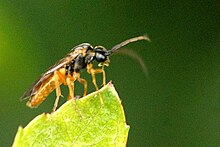Monostegia abdominalis
| Monostegia | |
|---|---|
 |
|
| Monostegia abdominalis | |
| Scientific classification | |
| Kingdom: | Animalia |
| Phylum: | Arthropoda |
| Subphylum: | Hexapoda |
| Class: | Insecta |
| Order: | Hymenoptera |
| Suborder: | Symphyta |
| Superfamily: | Tenthredinoidea |
| Family: | Tenthredinidae |
| Subfamily: | Allantinae |
| Tribe: | Empriini |
| Genus: |
Monostegia O. G. Costa, 1859 |
| Species | |
|
|
Monostegia is a genus of sawfly. The authority is based on the description by Achille Costa and Oronzio Costa, although earlier work grants this to Fabricius 1798., though the commonest species, M. abdominalis, bears the authority of Fabricius.
Adults: Head and thorax are black, with some yellow parts including mouthparts. Legs and abdomen mainly yellow, wings suffused with brown. Eggs: Smooth, white and oblong measuring 1 mm by 4 mm. Larvae: Caterpillar-like, growing from 2–4 mm to 16–21 mm. Pupae: Shorter and fatter measuring 8 mm in length, and become incereasingly melanized.
Species often include only M. abdominalis but some authorities describe up to four species, including;
Distribution is holarctic, from Europe to Asia Minor and the Caucasus in the south, through to Siberia. Though it was only introduced to North America from Europe in the 1950s, where it naturalised, its range continues to expand. In 1979 its North American distribution was from Quebec to New Jersey, and west to Ontario and Ohio but was detected as far west as Washington State in 2016 in the United States and in Canada from Alberta in the west to the Maritimes in the east.
Sawflys are folivore phytophages (plant eating). Monostegia's economic importance lies in the destructive habits of its caterpillar-like larvae which feed on the leaves of plants of the Primulaceae family, principally Lysimachia (such as yellow loosestrife, (Lysimachia terrestris)), and Anagallis (pimpernel). Original reports in North America involved Lysimachia nummularia as the host plant, but L. terrestris was identified in the 1960s.
...
Wikipedia
